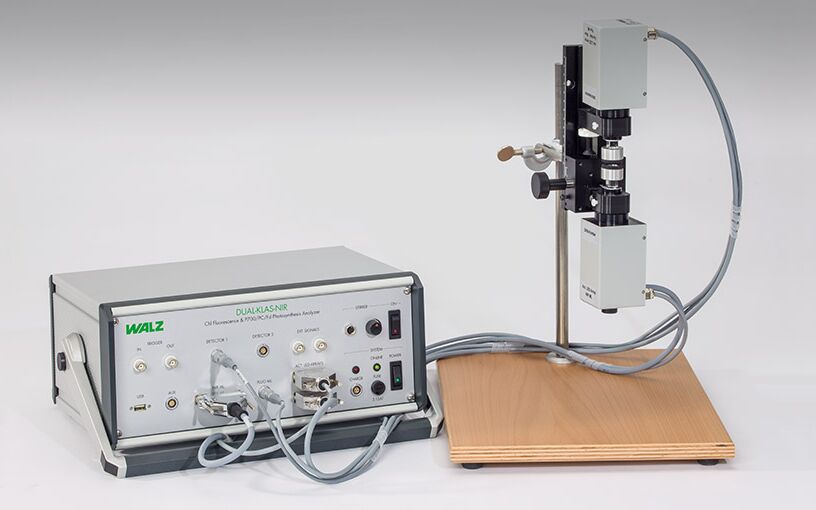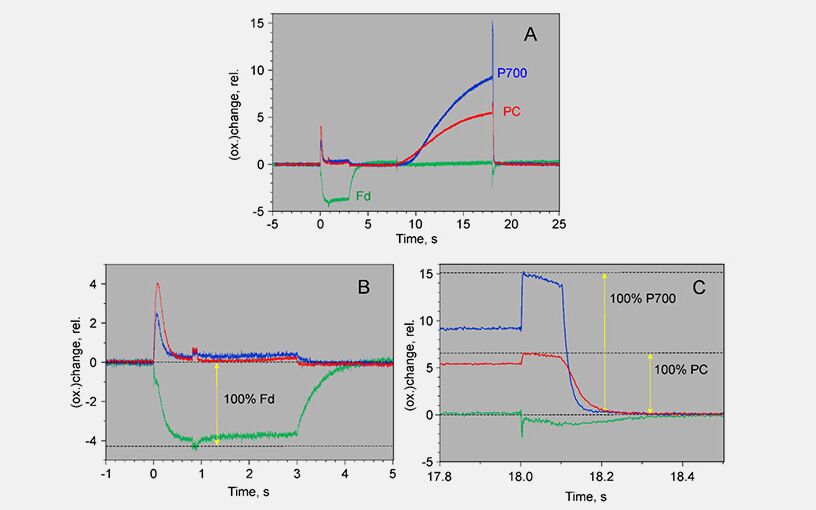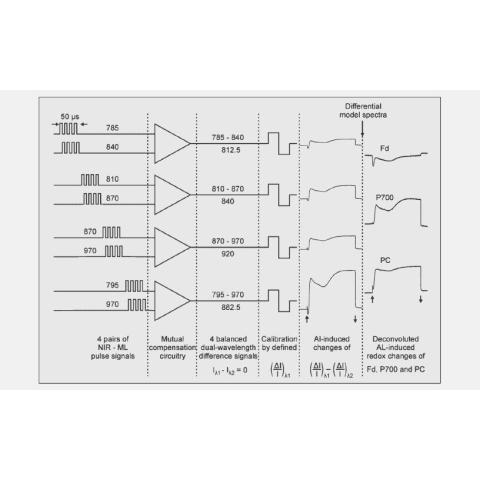DUAL-KLAS-NIR
P700, Plastocyanin, Ferredoxin & Chlorophyll Fluorescence Measuring System
Caratteristiche
The DUAL-KLAS-NIR represents a significant advancement over the well-established DUAL-PAM-100 system. The DUAL-PAM-100 employs one pair of wavelengths in the near infrared (NIR) to measure absorption changes related to redox changes of the photosystem I reaction center. Using four wavelength pairs in the NIR, the DUAL-KLAS-NIR is capable of unequivocally discriminating redox changes of plastocyanin (PC), PS I reaction center (P700) and ferredoxin (Fd).
By applying an innovative analytical approach, the DUAL-KLAS-NIR acquires the in vivo spectral characteristics of pure PC, P700 and Fd. This spectral information allows the user to monitor online the redox changes of P700, PC and Fd, and to determine ratios of PC/P700 and Fd/P700.
Like the DUAL-PAM-100, the DUAL-KLAS-NIR is also a PAM chlorophyll fluorometer. The device can excite fluorescence by green or blue PAM measuring light. Green light penetrates deeper than blue light into the leaf. Thus, green-excited fluorescence includes information from deeper leaf layers and, thus, is well-suited for comparison with the NIR absorption measurements, which always probe the entire leaf.
The software of the DUAL-KLAS-NIR shares many features with that of the DUAL-PAM-100. Hence, getting started with the DUAL-KLAS-NIR is particularly straightforward for users of the DUAL-PAM-100. Using automated measuring routines of DUAL-KLAS-NIR software, even complex measuring protocols can be easily performed.
Outstanding features of the DUAL-KLAS-NIR
- The DUAL-KLAS-NIR is the only instrument that can split the NIR-signals (real time) into P700, ferredoxin and plastocyanin contributions
- Gives estimates of P700 to plastocyanin and P700 to ferredoxin ratios and thereby of pool sizes
- The simultaneous measurement of two fluorescence signals, and the redox states of plastocyanin, P700 and ferredoxin allow the user to characterize the whole electron transport chain in a single measurement

DUAL-KLAS-NIR control unit (DKN-C) left with the emitter and detector units held by the Linear Positioning System in the vertical position on the right hand side.
Bean leaf placed between the emitter and detector heads of a DUAL-KLAS-NIR and illuminated from both sides by red, 635 nm, actinic light during a measurement.

DUAL-KLAS-NIR control unit (DKN-C) left with the emitter and detector units held by the Linear Positioning System (horizontal orientation) on the right hand side.

Example of an experiment to scale the deconvoluted Ferredoxin, P700 and plastocyanin signals.
Outstanding Technical Features
DUAL-KLAS NIR instruments can measure in 1, 2 or 6 channel mode, with time resolutions of 35 µs, 150 µs and 1 ms, respectively.
The pulse modulation technique developed for the DUAL-PAM-100, in which the different channels are measured as blocks of 50 µs, has been extended for the DUAL-KLAS-NIR to accommodate 6 channel measurements (see Fig. 2).
The DUAL-KLAS-NIR uses green measuring light for the fluorescence measurements to get the best possible match between fluorescence and absorbance measurements. A second fluorescence channel detects the fluorescence induced by blue measuring light. The blue measuring light gives more specific information on the upper or lower side of the leaf and in addition gives a fluorescence signal that is one order of magnitude larger than the signal induced by the green measuring light.
Other Distinctive Features of the DUAL-KLAS-NIR
Integrated red, blue, far-red actinic LEDs, whereby the 635 nm red LED-array is used as the light source for continuous actinic illumination, multiple turnover pulses and single turnover flashes. The blue 460 nm LED in the detector unit allows a continuous illumination with up to 300 µmol m-2 s-1 from the detector side of the sample.
The measurement of four wavelength pairs in the near-infrared: 785-820, 820-870, 870-950, 840-950 nm.
Both sides of the leaf can be illuminated to achieve the most homogeneous illumination of the leaf possible.
An extremely wide range of measuring light frequencies (1 Hz to 400 kHz) allows continuous assessment of the FO level as well as recording of fast kinetic transients at high time resolution (e.g. the polyphasic fluorescence rise or flash relaxation kinetics).
All light sources can be switched with 2.5 µs time resolution under software control. If single channel measurements are made, a script is available with which the different signals can be measured consecutively at high time resolution.
Other important technical features are: 1. Automated Slow Kinetics recordings; 2 pre-programmed Triggered Runs; 3. on-line and off-line averaging; 4. Operation of the instrument via automated measuring routines (script file programming).
Richiesta quotazione


